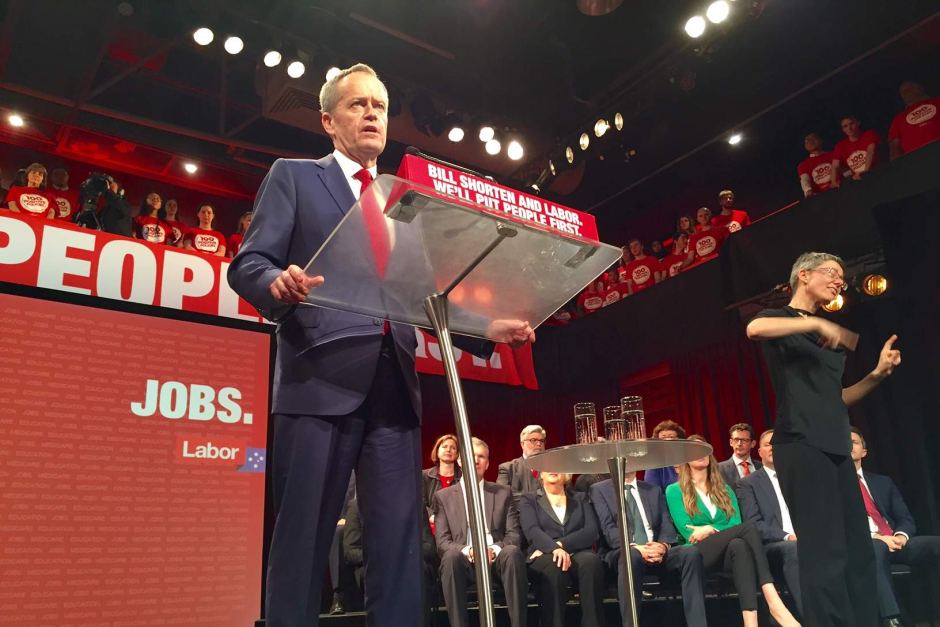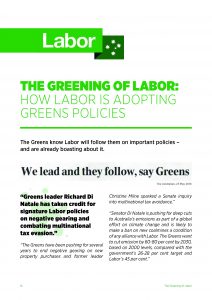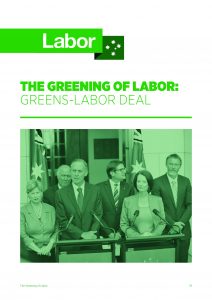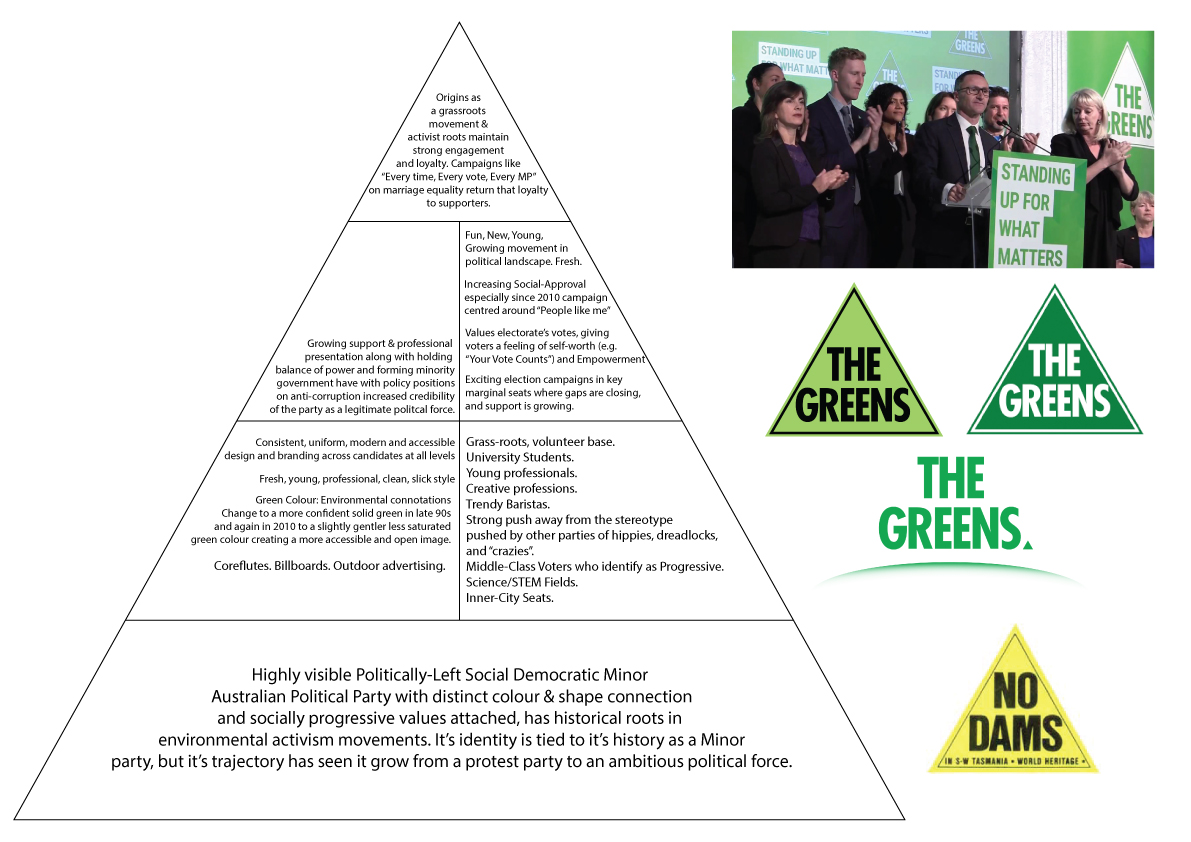Assessment 1: Brand Equity Diagnosis
Compare and contrast two brands narratives. The chosen brands are the Australian Labor Party and the Australian Greens.
Some historical and political context is required for an effective analysis of these brands’ narratives.
Comparing and contrasting the Australian Greens (AG) and the Australian Labor Party (ALP) in terms of their brand narratives and public perceptions is a particularly interesting exercise due to the delicate tug-of-war between the two parties when looking at the historical context that is best labelled the rise of the Australian Greens. The two parties compete for many of the same voters and have at various times been both allies and enemies, as the AG shift focus from purely Senate races to contesting, more seriously, lower house seats the two brands present both threats and opportunities to one another. Examining both brands since 2010-2017 allows for examination of the AG after their breakthrough performance in 2010, and ALP through the latter part of the Rudd-Gillard-Rudd through to opposition under Shorten.
Both parties traditionally sit to the left of the political spectrum, in 2010 the Australian political environment’s centre had shifted unexpectedly to the left, and the AG appear to had opened up the political space to the left of ALP. Shaun Wilson (Australian National University, 2002) described AG voters as ‘representing a constituency that was concerned with more than environmental issues’ and claimed ‘many were Labor supporters, disillusioned with their party’s diminished commitment to full employment and economic redistribution’ as ALP moved towards an economic agenda typically set by the political right with the 1990s emergence of Third Wave politics, narrowing the divide between the traditional major parties of Australian Politics, and moving the identity of the ALP closer to the Liberal National Coalition (LNP).
The LNP, particularly in recent years since the Gillard Minority ALP government, have attempted to paint an image, sometimes quite literally, of the ALP being the AG in Red clothing. Producing a whole website called “The Greening of Labor” which applies brand aspects of the AG to ALP branding and places a whole sinister soundtrack over content clearly devised to scare the pants off any LNP-ALP swing voters who might consider ALP but not AG, and plays to lingering Carbon Tax narrative of the LNP. It uses terms like “dragged radically to the left” and “taking over the ALP” to attack the ALPs brand with a negative stereotype of the the AG and environmental movement that has persisted since it’s founding and is evident in rhetoric towards the AG of ‘feral obstructionist’, communism and ‘crypto-fascism’ from LNP and Family First (FF) figures like Sen. George Brandis, Alexander Downer, Sen. Nick Minchin, John Anderson (Nat) and Sen. Steve Fielding from the 1980s through to today.
LNP produced pdf/website criticising ALP as being beholden to the AG agenda.
Despite the claims of the LNP, the ALP and AG have not had the most harmonious relationship, often preferencing deals expose this with both parties usually positioning opposed to the LNP, but neither wanting to hand their own support to the other, resulting in ALP directing preferences to other minor parties such as One Nation (ON), FF or even in some contests to the LNP despite values and policies of these parties conflicting more strongly with values and policies of the ALP. The Rudd Government, for example, refused to work with the Greens, while his successor formed an alliance with them. In regard to preferencing of FF or ON, the ALP presents a weakness in their brand narrative which is often seized upon by the AG to attack the ALP. When it comes to competition between the AG often become targeted by ALP with similar rhetoric as the LNP deploys, being labelled as fanatic or extreme. This uneasy relationship is surely rooted in competition for support, particularly the view that growing AG support poses a threat to ALP support, which provides a platform for a narrative position against the AG within the ALP that strategically it’s a wasted vote to give support to a third party and divide opposition to the LNP, while the AGs particularly since securing a lower house seat in the past three federal elections positions itself as a third option to the “old parties” and a brand that holds integrity and values in high regard as the “business-as-usual two-party system” comes to an end.
At this point, with this context in place, it is worth employing a SWOT analysis and CBBE model analysis to the two brands to discern the divergence of the two parties.
SWOT – AUSTRALIAN GREENS

STRENGTHS
The AG current brand strength lies in their narrative as an emerging power in Australian politics, and their energetic optimistic outlook, positioning themselves as a legitimate third option outside the duopoly of LNP and ALP. They have managed to move beyond being seen as a purely environmental party, and from their 2010 campaign onwards they have built a strong narrative against their detractors who have painted them as a band of hippies and ferals. Their campaign of “This time I’m voting Green” and “My values haven’t changed but my vote has” are strong examples of Community Based Social Marketing that transformed the party into a modern, accessible party reinforced by a story to “green-leaners” that ‘people like me’ vote Green. Their high level of door-to-door grassroots campaigning and fence coreflutes reinforces to voters that it’s a normal, middle-class thing to support greens and that even the neighbours are doing it. Their messaging that “Your vote is powerful” and “We don’t have the money of the Old Parties, but we have the people power” works to overcome the perception that ‘even if you support the Greens policies, it’s a waste to vote for them instead of major parties’. Their campaign of nice, normal looking people, holding green triangles with key policy issues that make them vote Green is a strong campaign for repositioning the Greens as a viable option on more than just environment, collectively it paints a narrative of being more than single-issue politics, and reinforces the narrative that people like you vote Green and they’re motivated by the same issues you care about. Finally the slogan “Standing up for what matters” ties all this together and applied with very consistent branding across all candidates at all state, local and federal level elections the AGs have crafted a narrative as a professional and serious political option for voters, and an option that is in touch with the ‘real issues’ that ‘matter’ to voters. They have built a strong membership of around 10,000 members. Has a unique position on military engagement in Middle East, public dental care and gay marriage (although this position is no longer unique now being shared by ALP the AG often say “every vote, every MP” to remind voters that unlike ALP the AG have always supported it, not just when it’s politically convenient). In 2010 AG became the first third-force party to win a lower house seat, got the highest ever number of senate seats for a third-force party and the highest percentage of senate votes.
WEAKNESSES
As a minor party, the AG have some inherent issues, there is a perception that they will never hold Government (despite forming minority with ALP previously) and that a vote for them is a wasted vote. These are being addressed in their narrative as mentioned above. Their historical roots in Environmental Activism as still important to their brand and they often appear at public rallies and protests around issues important to them, this does form a barrier for them pushing past their existing supporters and is often used by their critics to attack them, conversely though this fits their ‘standing up for what matters’ messaging. On occasion the AG take a strong public stance, whether to differentiate themselves or not is unclear, on issues that may be painted as marginal concerns to the national interest, such as decriminalisation of narcotics (preferring a health approach to a criminal approach) lending credibility to claims they are not a real option for most voters. Greens activists and political experts have both noted that the AG ideological beliefs likely only resonate with a small percentage of Australians and that AG relies on fluctuations of voters disillusioned with their regular parties, and such support is fickle, the Greens primary vote has often shifted in relation to what ALP is doing, eg. when Rudd didn’t move on Climate change AG vote swung from 11% to 16%, when Gillard entered it dipped back to 10% and quickly rose again to 12% when Gillard failed to move on climate change.
OPPORTUNITIES
The is certainly much room for the AG to grow their narrative around a number of emerging important issues such as the shifting workforce post-Fourth Industrial Revolution (4IR) and various state arms of the AG have begun sharing links on Social Media about stories in other countries of basic income trials and changes to full-time working hours. The Greens core narrative of Ecological Sustainability, Social Equality & Economic Justice, Grassroots Democracy, and Peace, Disarmament & Non-Violence provide a solid footing from which to branch out their narrative and follow any discourse that opens up around new policy matters. There is certainly an opportunity to gain support from the ALP’s base and in recent times numerous unions have supported the AG rather than ALP. The AG have a large volunteer base and strong support with younger voters, this makes them early adapters to emerging platforms for communicating their narrative and they were certainly amongst the first in Australian politics to deploy Facebook profile images for their supporters to use leading into elections, this was quickly imitated by all other parties and is now common practice, there is opportunity for the AG if they continue to be early adapters. The AG have made much headway in positioning themselves as a legitimate party to place your votes with, as a credible option and a professional serious political party, there is still much opportunity to expand their image as a true third party of Australian politics and, the party of the left. The AG rise began in the 90s when there was an undercurrent of voter unhappiness with the political scene, this was seen in the fall of the Australian Democrats, the rise of environmental parties on one hand and the rise of Pauline Hanson’s One Nation on the other. ON’s recent return, the ALP and LNP leadership spills and global political upsets from Trump to Brexit suggest that this could be another window of opportunity for the AG to appeal to widespread voter dissatisfaction with the status quo with a positive outlook and policy set. As with the Franklin Dam that thrust the AG into the national political landscape, issues facing the Great Barrier Reef (GBR) provide a platform for the AG brand to advance on it’s natural/historical home turf, it should be recognised that since the Franklin Dam issue that environmental issues can disturb long-term party loyalties. AG have opened up space to the left of the ALP and taken up a number of causes traditionally held by the ALP, whenever the ALP moves to the right on an issue is an opportunity for the AG. Marginal seats that were close races provide a great opportunity for the AG including, Sydney, Grayndler, Higgins, Batman, Denison, Wentworth, Melbourne Port, Bass, Richmond and Cunningham. With a Greens MP in the seat of Melbourne, electorates that border Melbourne are also windows of opportunity. Former Labor Sen. John Black views these seats as opportunities for the AG as they are dominated by “well-to-do professionals, who are intellectually liberated” who are concerned with environmental issues and concepts of human rights – policy areas the senator seems to think blue-collar voters are not concerned about. There is an opportunity for AG to push back against the ‘mean-spirited’ politics that settled to dominance after Howard’s repudiation of Keating’s brand of cosmopolitan culture, this is where the ALP have failed. Opportunities exist in again potential collaboration with a major party (most likely ALP)
THREATS
There are many external threats to the AG, while proportional representation in the Senate allows them to gain seats in the upper house of Parliament, the preferential system of the lower house has been a continued challenge to their success and will continue to prove difficult (though they have recently secured a lower house seat and a number of recent federal elections have seen either 2 horse or 3 horse races involving AG and major parties). The ALP and LNP remain popular with voters and this undermines the narrative of the end of the two party system. The ALP pose a significant risk to the AG, both through preferencing deals that weaken the AG position and through their adoption of similar stances on various key policy positions. The ALP can usually count on AG preferences flowing to them before the LNP – this has been the case in every election since 1990 (Bennett, 2008) and in the 2004 Commonwealth election, for example, AG preferences helped elect ALP MPs in at least 21 electorates, in fact, 79.7% of AG preferences nationwide went to ALP. However, so long as the ALP is threatened by the growth of AG support, the AG can not always count on this flow returning. While often siding with the ALP, to remain seen as an independent third political option the AG must stand against both ALP and LNP, and distinguish itself from them both. Populist narratives and the “jobs. jobs. jobs.” three-word mantras of the major parties still appeal to a lot of voters and generate threats on lower house support. Since the split of the Labor Party in the 50s the AG have been one of four serious third-force parties in Australian politics, the others being DLP, Democrats, and One Nation, each of these have experienced periods of success and ultimately demise, with ON seemingly rising from it’s own ashes in the most recent election, AG must recognise that it is a threat to assume they are safe from a shift in the political sands – AG shares a lot of characteristics with these other parties, from it’s shaping by a vivid founding figure through to it’s deep roots in a particular state, it too could see a reduction in support as the major parties adopt policies to address the specific concerns that gave birth to the party. One final threat is the dominant political-economic ideology of the past 21 years, a post-Howard Australia is a neo-liberal Australia with a deep conservatism essentially the opposite of the values and narrative of the AG brand and a firing up of this sentiment presents a risk to social support for the AG.
SWOT – AUSTRALIAN LABOR PARTY

STRENGTHS
Simultaneously part of its strength and weakness the ALP’s brand narrative post-Rudd-Gillard-Rudd has been tethered very tightly to the identity of its leader. Bill Shorten, not the most charismatic man, and not without his involvement in the leadership issues of the Rudd-Gillard-Rudd years, has become the face of Labor and placed opposite the Abbott-Turnbull leadership spill the strongest thing for the Labor brand is now to stay united around a single stable leadership. ALP has also positioned its recent campaigns around “Putting People First” and “100 positive Policies” these are both always tied to the leadership and Bill Shorten, seen int eh coreflutes above it’s not just ALP that will put people first, it’s ALP under Bill Shorten, in the 100 positive policies brochure pdf there is only 1 image (of parliament building) that doesn’t feature Bill Shorten and a generic template of an Australian factory worker, teacher, student, young parent or serviceman. The language of the brochure presents a narrative of ALP as a party standing for ‘a fair go’ and positions people opposite ‘multinationals’ tapping into a strong point of public discourse post-GFC. Their rebrand that occurred around the same time as the Greens rebrand softens the colour palette slightly and presents a fresh face to a party that had an image problem of being chaotic and internally unstable. Their recent campaign reiterated “Jobs. Education. Medicare” again and again, giving a very clear, easy-to-access overview of their key focus.The ALP have done well tapping into voter dissatisfaction and promoting a positive and proactive narrative with the “positive policies” rhetoric as a means to attempt to address this. The ALP brand dates back to 1891 Shearer’s Strike and first election to Legislative Assemblies in a number of states (colonies at the time), this long history and association with workers still underlines modern Labor to some degree, although with it’s history of support for the White Australia Policy right up to 1973 Modern Labor tends to be more future focused than past, save for on topics of Gough Whitlam (equally one of their weaknesses), Superannuation, and Medicare.
WEAKNESSES
In many ways, Labor is a victim of its own successes. Today, a mine worker in WA earning $150,000 a year on fly-in, fly-out contracts has less taste for revolution than his predecessor and every interest in minimising his tax and maintaining the status quo. Much of the narrative is focused on Bill Shorten, which seems to clash with the slogan of putting people first, instead, it seems to be putting Bill first, literally the wording reinforces this. There is a lingering perception that ALP is bad at economic management, despite there being plenty of evidence to the contrary (see below) – this comes from a historical perception of the party and poor economic performance as far back as the 1970s. The ALP have been unable to shake this narrative. The ALP is still in the shadow of negative public opinion of the Carbon Tax (CT) and the Gillard Minority Government, again both the CT and Gillard Government were quite objectively effective, however, a very negative campaign by the LNP labeled Gillard as a liar and backflipper beholden to the AG and the Carbon Tax as a burden on the Australian voter, the ALP was unable to effectively counter this narrative and still lives in its shadow. Until recently the ALP has failed to reshape the discourse in a post-Howard Australia, the national political narrative has been more cut-throat since 1996, much more neo-liberal and the ALP have engaged in this and sacrificed its social democratic roots in the process, and opened space for the AG. Factional in-fighting and division between Left and Right factions of Labor – this is rarely part of the perception of ALP to those outside its membership but it a source of criticism from both the LNP and AG and historically has led to splits in the party. The ALP have also failed to maintain a unified brand image across all levels and all candidates. For example, the member for Hotham below uses the Green’s line of “standing up for” after a Facebook comment suggests a change from “fighting for”


Labor’s Economic Management Links: (for some reason these wouldn’t hyperlink where I wanted them to above)
[1] https://theconversation.com/the-idea-that-conservatives-are-better-economic-managers-simply-does-not-stand-up-56678
[2] http://www.theaustralian.com.au/national-affairs/alp-best-manager-of-money-history-shows/news-story/4f839671b2259db64f3db6caebb933e8
[3] http://www.abc.net.au/news/2015-03-12/dunlop-the-myth-of-coalition-economic-management/6308704
[4] https://www.theguardian.com/commentisfree/2016/may/02/labors-economic-record-is-better-than-the-coalitions-and-they-must-make-it-count
[5] https://www.theguardian.com/business/grogonomics/2016/jun/14/new-research-abbott-and-turnbull-the-worst-economic-managers-since-menzies
[6] http://www.smh.com.au/comment/liberals-are-not-better-economic-managers-20150318-1m1we2.html
[7] https://meanjin.com.au/essays/the-economy-of-best-perceptions/
[8] https://www.macrobusiness.com.au/2016/10/better-economic-managers/
OPPORTUNITIES
There have been recent attempts to emulate the grassroots nature of the AG within ALP after a major loss of support it’s an attempt to reconnect with the base supporters, there’s an opportunity to focus more on these supporters than on the party room and MPs, this opportunity exists within the current narrative of “putting people first”. ALP can grab support back from AG by appealing to similar policies, for example both parties support full Gonski funding for Education, both support Marriage Equality, both are in favour of protecting penalty rates and Medicare, while the ALP needs to downplay their differences to the left voters, such as their positions on Refugees, they must make a point of them to the right, placing them as a centre-left party that has the possibility of actually making policy change happen, and the capacity to actually form Government. They also have the opportunity to really reposition and readdress their misperception as poor economic performers. The poor performance of the Turnbull Government and low approval ratings create an opportunity for the ALP to appeal as an alternative to the many who see the political landscape as a two-party system.
THREATS
While the ALP poses a threat to AG growth, the AG continue to pose threat to ALP, both in leaking support from ALP to AG and in reputational risk to ALP. If they chase those voters they’re losing to the left they will be labelled by LNP as beholden to the AG, and if they abandon them then AG grow and attack the ALP for drifting to the right leeching more supporters from ALP, and potentially diverting preferences away from ALP. If the AG did gain more lower house seats this would be a significant threat to the ALP holding Government with a significant majority, and forming a minority with them would leave them open to threats of again be labelled as puppets to the AG. The ALP relies on AG preferences, if they alienate the AG voters too much in distancing from AG they risk their own seats, the Greens take voters from ALP but then return preferences to the ALP. Due to this, it’s a threat to the party to attack the AG but also a threat to their brand narrative to be too cooperative.
CBBE – Customer-Based Brand Equity Model
According to the model, building a strong brand involves four steps: (1) establish-ing the proper brand identity, that is, establishing breadth and depth of brandawareness, (2) creating the appropriate brand meaning through strong, favorable,and unique brand associations, (3) eliciting positive, accessible brand responses,and (4) forging brand relationships with customers that are characterized byintense, active loyalty. Achieving these four steps, in turn, involves establishing sixbrand-building blocks—brand salience, brand performance, brand imagery, brandjudgments, brand feelings, and brand resonance. (Keller 2001)

















